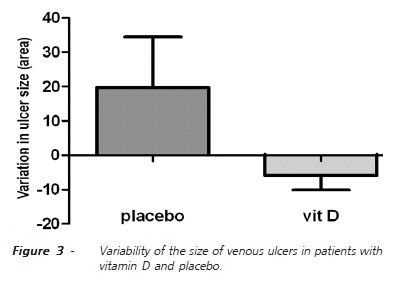OBJECTIVE: To analyze the relation between vitamin D insufficiency and wound healing in patients with venous ulcers; to correlate vitamin D insufficiency with characteristics of the ulcer (size and pain) and to evaluate if reposition of vitamin D in these subjects expedites ulcer healing. METHODS: We selected 26 patients with leg ulcers, and 26 control patients without ulcers, matched for gender, age, systemic arterial hypertension and tobacco use. The venous ulcer group was divided in two subgroups: one that received placebo (nine patients) and other receiving vitamin D, 50.000 IU per week over two months (13 patients). Blood was collected for 25 OH vitamin D dosage before and after the medication. In the ulcer group, we obtained data concerning demographics, leg ulcer size, as well as pain severity, measured by an analogical visual scale. Data was grouped in contingency and frequency tables, the tests of Fisher and chi-squared being used for nominal variables and Mann-Whitney for numerical variables. The adopted significance was of 5%. RESULTS: We found vitamin D insufficiency in the great majority of the patients. The median level in the ulcer group was 17.05 ng/dl and 22.75 ng/dl in the group without ulcer (p=0,0182) No relation was found between the ulcer size without treatment and the level of vitamin D. After treatment, the average size of the ulcer changed from 25 cm² to 18 cm² in the patients that took vitamin D and from 27 cm² to 24,5 cm² in the placebo group (p=0,7051 and p=0,7877, respectively). Considering the variability of the size of the ulcer in the treatment group versus placebo group, the average size was equal to -0,75 cm² in the first group and +4cm² in the second (p=0,0676) CONCLUSION: Patients with leg ulcers have more vitamin D deficiency. No difference in the ulcer characteristics was noted between those with and without vitamin D deficiency. There was a trend toward a better healing in those with vitamin D reposition.
Venous insufficiency; Skin ulcer; Leg ulcer; Vitamin D deficiency; Wound healing




